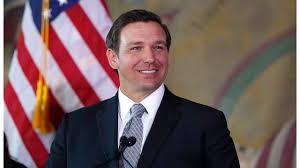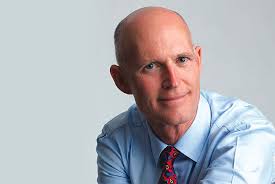When it comes to climate change, there’s been a sea change in Florida politics.
The new attitude starts at the top, where Gov. Ron DeSantis last month appointed the state’s first Chief Science Officer to find “science-based solutions” to environmental concerns, particularly the blue-green algae and red tide outbreaks that have tarnished Florida’s cachet.
Now the governor is advertising for a Chief Resilience Officer, someone who will work to “prepare Florida for the environmental, physical and economic impacts of climate change, especially sea-level rise.”

The new positions represent a watershed moment in a state with more to lose than any other. It feels like that moment in the Wizard of Oz, where the movie turns from black-and-white to color. That both offices will be housed in the governor’s suite — and report directly to DeSantis — sends a serious message.
With the exception of House Speaker José Oliva, Florida’s Republican leaders no longer deny the reality of climate change, which every major scientific organization recognizes is real, is exacerbated by human activity and poses an existential threat.
Even our former governor has changed his tune. “Climate change (which is real and requires real solutions) is the religion of the new Left in America,” U.S. Sen. Rick Scott wrote in a recent Orlando Sentinel op-ed.
Sure, the former governor placed the words in parentheses and in a disparaging context. But, look. Even Rick Scott is using the words “climate change” and recognizes it’s real. Perhaps he can now share his thoughts on real solutions.

“Climate change isn’t something people get to choose to believe or not, it’s happening,” U.S. Rep. Matt Gaetz of Fort Walton Beach, one of President Trump’s biggest cheerleaders, said in a recent interview with Vice. “I can tell the earth is warming based on overwhelming scientific evidence and I don’t think it’s a coincidence that we’ve released like 300 years of carbon in the last several decades.”
Miami state Sen. José Javier Rodríguez, who wore rainboots during the legislative session to keep climate top of mind, told us “there’s not a debate on science anymore. It’s an economic and fiscal debate, and I think that has been helpful.”
A sense of optimism is emerging among Florida scientists, environmentalists and government officials who have spent the past eight years frustrated by the Scott administration’s head-in-the-sand approach to the rising waters, extreme rainfalls and more-powerful hurricanes on the radar.
But while encouraged, they’re also reserving judgment. For while DeSantis pushed the Legislature to find $686 million for Everglades repair, Lake Okeechobee fixes and springs restoration — all important elements of the climate-change picture — his muscle was missing behind a bill that would have required state contractors to consider sea-level projections when building in coastal areas.
Also, the celebration of a new red tide task force fed some skepticism. Given all that’s known about the causes and migration of red tide, those on the front lines would have preferred pollution controls and investments in water treatment.
And in a record-setting $91 billion state budget, only $26 million was set aside to address county water projects related to sea-level rise, such as stormwater drainage, canal erosion and failing septic tanks. Of that, Palm Beach County is poised to get $1.26 million for four small projects; Miami-Dade will get $5.4 million for 16 projects; and Broward, which always draws the short straw, will get $700,000 for three small projects.
But let’s cut the governor a break. He just took office in January. And his environmental secretary, Noah Valenstein, was key to helping advance the sea-level rise planning bill through two Senate committees, though it never reached the floor.
So, in the spirit of encouragement, we offer these suggestions on how best to position the state’s new chief resilience officer (CRO) for maximum success.
*Give him or her a budget and staff. It’s great to name a spokesperson, a leader, an evangelist to talk about the need to prepare for the changes coming our way. But without financial muscle, plans will gather water on the shelf.
*Let him address energy, too. To attract the best candidate, don’t restrict the scope to adaptation. Let Florida’s CRO champion a clean-energy plan that lessens the state’s reliance on fossil fuels. Greenhouse gases like carbon dioxide, which last week reached a record-high level of 415 parts per million, are heating our planet. To help avoid the worst-case scenarios of climate change, Florida should lead on clean energy in a big, enormous way.
*Establish sea-level rise projections for all regions of Florida. Then, draft a resilience priority plan for raising roads, hardening critical infrastructure and discouraging development in low-lying areas. Pay special attention to vulnerable stormwater and wastewater systems, and the availability of fresh drinking water. Ensure resiliency is part of every state project.
*Think big. South Florida’s aging flood-control system needs to be rethought and rebuilt. During king tides, some gates can no longer open because seawater is higher on the other side. That means more inland flooding, more canal erosion and more loss of land. Working with the governor, the CRO should marshal all resources necessary to focus the federal government on its responsibility to protect our at-risk region from flooding. That includes raising seawalls along its Intracoastal Waterway.
*Insist on coordination between local and regional governments, particularly the state’s five water management districts. Up to now, there’s not been much. Miami, Hollywood and Delray Beach may do all they can to raise seawalls or install tidal valves that keep seawater out of stormwater systems, but if the water management district doesn’t commit to implementing regional solutions, city solutions will falter.
*Use the Florida Climate Institute — an association of 10 Florida universities — as a kitchen cabinet. Encourage lawmakers to fund research on the questions the state needs answered, like projections for future rainfall and rising groundwater tables.
*Speak the language of the financial markets. Long before we ever get wet, our insurance rates will rise. So will the cost of borrowing money. To get ahead of the problem, Florida’s CRO should ensure that every dollar spent reduces our risk in the eyes of the insurance and credit markets.
“Every time you spend any money — whether raising roads, or building seawalls or using green, nature-based solutions to soak up the storm surge, please Florida, be able to demonstrate that this intervention reduces the one-in-100-year flood loss by X percent,” says Daniel Stander, global managing director for Risk Management Solutions in London. “If the CRO doesn’t do that, it’s the market that will tell Florida’s story.”
Under Gov. DeSantis, Florida’s story on the climate crisis is starting a new chapter.
The governor is to be commended for creating these two cornerstone positions. As he pursues more building blocks needed to protect our future, we encourage him to remain bold.
“The Invading Sea” is a collaboration of four South Florida media organizations — the South Florida Sun Sentinel, Miami Herald, Palm Beach Post and WLRN Public Media.



